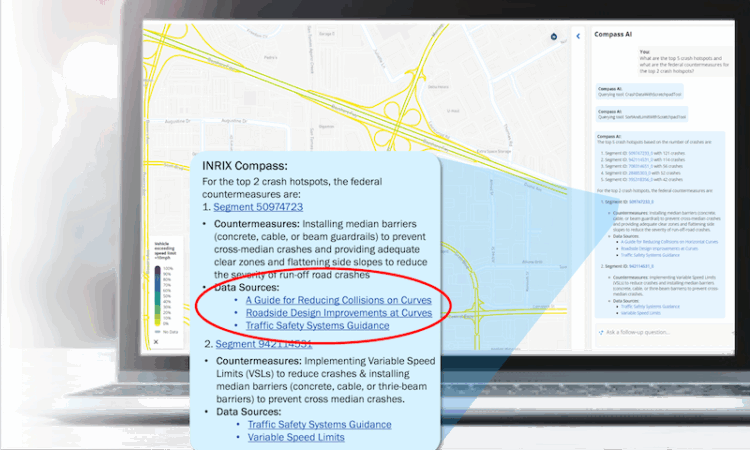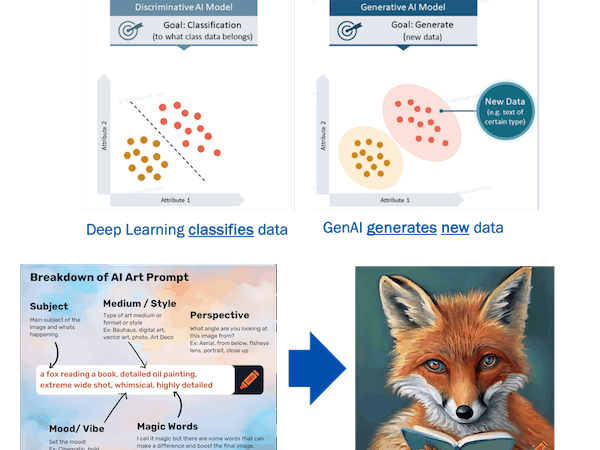
Artificial Intelligence (AI) is no longer a futuristic buzzword—it’s actively reshaping how we manage transportation systems. As public agencies face mounting challenges—limited staff, increasing demands for data-driven decisions, and outdated legacy tools—the rise of AI technologies like Machine Learning (ML), Deep Learning (DL), and Generative AI (GenAI) offers new ways to improve safety, reduce congestion, and streamline planning.
This blog breaks down the differences between these technologies, explains the value of probe data, explores how Large Language Models (LLMs) accelerate decision-making, and shares how INRIX is bringing these technologies to life through INRIX Compass.
The Fuel Behind AI: What Is Probe Data?
Before we explore the different types of artificial intelligence and how they’re reshaping transportation, it’s important to level-set on the data that powers it all: probe data. AI is only as effective as the information it learns from—and in transportation, that foundational input is often anonymized movement data collected from connected vehicles and devices.
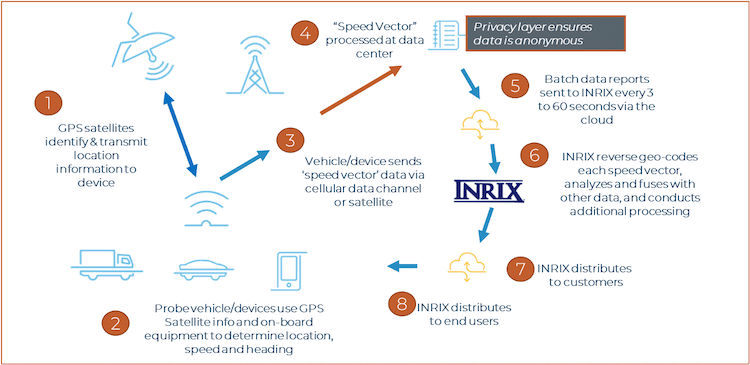
Key Characteristics:
- Infrastructure-free: Vehicles/devices act as
the sensors
- 24/7 coverage of network conditions
- Mixed vehicle types: passenger, freight, and more
- Mixed ping rates: some report every few seconds, others less frequently
- Captures speed, location, heading, and time anonymously
At INRIX, this data is processed through a secure pipeline—from GPS satellites to cellular networks to anonymized speed vectors—before being analyzed and fused with additional datasets to generate transportation intelligence.
What’s the Difference? Understanding the Spectrum of AI
Artificial Intelligence (AI) is just computer software that mimics the way humans think to perform complex tasks.
From recognizing patterns to generating new content, AI enables machines to learn from data and perform increasingly advanced functions that once required human decision-making.
At INRIX, we categorize these AI technologies based on how they process inputs and generate outputs:
| AI Type | Input Complexity | Output Complexity | Analogy | INRIX Use Case |
| Machine Learning | Simple | Simple | GPS app telling you the best time to leave | Travel time, incident detection, signal performance |
| Deep Learning | Complex | Simple | Netflix learning your viewing habits | Crash prediction, parking occupancy forecasting |
| Generative AI | Complex | Complex | Asking ChatGPT to write a personalized vacation itinerary based on your interests, travel history, and budget | INRIX Compass for safety planning and project prioritization |
Each level offers more flexibility—but also requires more compute time, training data, and context.

Machine Learning: Turning Big Data into Smart Predictions
Machine Learning is a foundational type of AI that enables systems to learn from historical data and improve over time—without being explicitly programmed. It’s fast, consistent, and ideal for answering repeatable, clearly defined questions.
INRIX has been using machine learning in transportation for decades.
Applications:
- Travel time estimation
- Traffic prediction
- Signal performance monitoring
- Incident detection
- Predictive maintenance
- Demand forecasting
- Ramp metering
- Routing optimization
Machine Learning uses algorithms trained on structured data to produce simple outputs—faster than any human could.
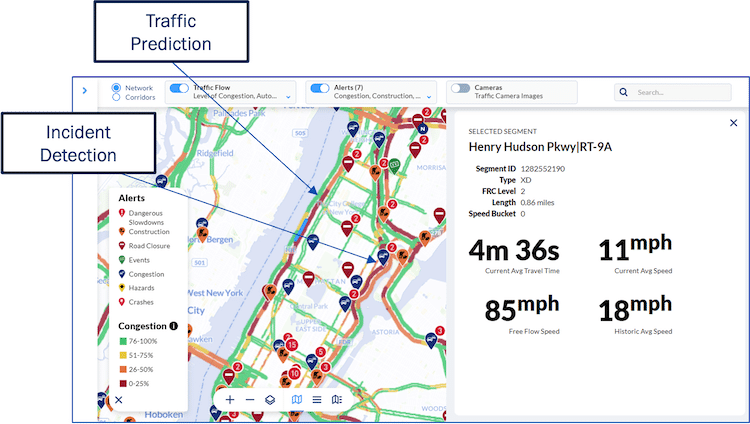
Deep Learning: Recognizing Patterns in Complexity
Deep Learning builds on Machine Learning by using neural networks to interpret large, complex, and unstructured datasets. It’s especially useful for recognizing nonlinear or hidden relationships between variables.
INRIX Uses of Deep Learning:
- Crash prediction models
- Curb space demand and availability forecasting
- Speed predictions days or weeks in advance
- Data normalization as sources evolve
Deep Learning allows for deeper, more nuanced insights from probe data, revealing patterns that would otherwise remain hidden.
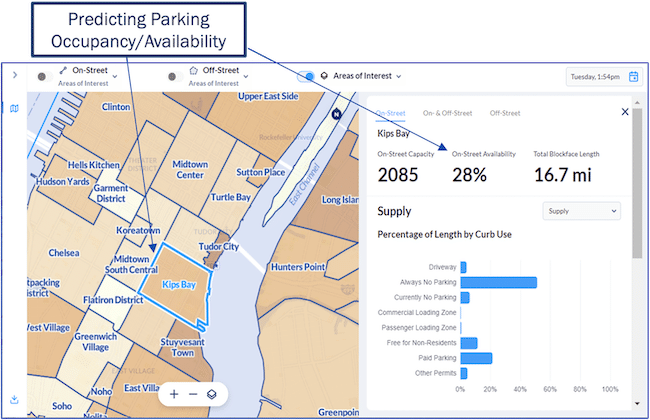
Generative AI: Human-Like Insight at Machine Speed
Generative AI (GenAI) takes AI to the next level. Built on foundation models and powered by Large Language Models (LLMs), GenAI enables systems to generate new content—text, images, answers, or recommendations—based on a mix of structured and unstructured inputs.
It’s not just about answering a question; it’s about understanding context, synthesizing information, and producing something useful in response.
Examples in Transportation:
- Producing a prioritized list of high-risk corridors based on crashes, VMT, and pedestrian exposure
- Suggesting safety countermeasures aligned with MUTCD and Highway Safety Manual guidance
- Explaining complex network performance trends in plain language
GenAI acts like a virtual transportation professional—able to interpret data, apply policy knowledge, and offer clear, actionable insights.
Generative AI is a Powerful Tool—Not a Magic Wand
Artificial Intelligence can be transformative—but only when used intentionally. Just like spreadsheets revolutionized how we analyze and manipulate numbers, AI has the potential to accelerate how transportation professionals work with data dramatically.
But a spreadsheet doesn’t create insights on its own—you have to structure it, feed it, and know how to interpret the results. The same is true for AI.
AI is not a black box that magically delivers answers. It doesn’t replace human expertise—it enhances it. It helps analysts, planners, and engineers get to better decisions faster. But only if you understand its limitations and apply it to the right questions with the right data.
And that’s the key to success with AI:
Managing expectations, validating outputs, and using it as a decision-support tool—not a replacement for professional judgment.
INRIX Compass: Generative AI Built for Transportation Professionals
To bring the power of GenAI directly to public sector agencies, INRIX launched INRIX Compass—a generative AI engine purpose-built to transform INRIX’s massive transportation data lake into actionable, conversational insights.
Compass helps users ask smarter questions, explore deeper insights, and make better decisions—faster. It’s a scalable, low-lift way for agencies to begin realizing the potential of GenAI without building their own solutions from scratch.
We introduced Compass with INRIX Mission Control, an executive dashboard that enables agencies to interact with their transportation system via natural language prompts. Users can ask questions like “Is traffic at this junction typical for this day/time? ” or “why is there so much congestion on this road segment right now now? , and get answers backed by real data.
From there, Compass evolved.
We built a proof of concept for a large U.S. transportation agency that integrated Compass into safety workflows—analyzing crash and exposure data to pinpoint high-risk areas and recommend countermeasures in real time. The application helps agencies align their Vision Zero and HSIP efforts by generating data-backed safety strategies—at the click of a button.
We are actively working to embed Compass across a variety of INRIX tools to bring GenAI-driven insights to use cases such as safety, traffic signal management, planning, and curb management.
Compass is powered by Amazon Bedrock, enabling us to securely and scalably deploy LLM capabilities across our platform. This partnership ensures that transportation data stays protected while unlocking cutting-edge AI performance.
Want to Test the Waters with GenAI? What You Should Know First
Generative AI is unlocking new possibilities in transportation—but it’s important to go in with your eyes open. While GenAI can help agencies act on their data faster and more efficiently than ever before, deploying these tools from scratch requires significant time, resources, and technical expertise.
That’s why INRIX has done much of the heavy lifting for you.
We built INRIX Compass to give agencies a turnkey way to explore and benefit from GenAI—without needing to hire machine learning engineers or architect LLM infrastructure. Whether you’re interested in improving safety, optimizing traffic signals, or understanding multimodal demand, Compass helps you ask smart questions and get intelligent, data-backed answers.
We’ve already:
- Built a secure and scalable GenAI engine
- Integrated it with our comprehensive probe data lake
- Developed transportation-specific workflows and prompts
- Proven it out in partnership with major public agencies
For agencies that want to hit the ground running, INRIX can be your guide. We help you unlock the power of your data—safely, responsibly, and effectively—so your team can start testing, learning, and applying GenAI right away.
But while Compass makes it easier, it’s still important to understand the challenges and limitations GenAI presents:
- GenAI will give you an answer—right or wrong. Outputs need to be tested and validated.
- Job displacement is a concern, but GenAI can also reduce reliance on consultants and empower existing staff.
- Scalability can be a challenge for agencies without robust infrastructure. INRIX helps bridge that gap.
- Over-reliance can reduce critical thinking. Use AI as a tool, not a replacement.
- Privacy and copyright concerns must be addressed with enterprise-grade safeguards like those built into Compass.
AI is powerful—but only in the hands of those who understand it, use it purposefully, and hold it accountable.
Research & Policy Resources: Guiding the Future of AI in Transportation
Public agencies and research institutions are actively working to support the responsible, ethical, and effective use of AI in transportation.
FHWA – ITS Joint Program Office (JPO)
The U.S. DOT’s ITS JPO has led foundational research and guidance, including:
- Artificial Intelligence for ITS: Challenges and Potential Solutions
- Potential Application of AI in Transportation
- Identifying Real-World Transportation Applications Using Artificial Intelligence
ITS America
The Intelligent Transportation Society of America has developed forward-looking guidance, including:
- AI Policy Principles – Recommendations for safe, equitable deployment
- AI Decoded – Demystifies AI for planners, engineers, and communities
- The Impact of AI on Transportation and Mobility – Explores real-world applications and future opportunities
These organizations emphasize that AI is not a destination—it’s a strategic transformation. With thoughtful governance, transparency, and public trust, AI can make transportation safer, smarter, and more sustainable.
Final Thoughts
Machine Learning, Deep Learning, and Generative AI are not just buzzwords—they’re essential tools for transforming transportation planning and operations. When applied to high-quality probe data and integrated through platforms like INRIX Compass, they help agencies make faster, smarter, and more confident decisions.
But the key to success isn’t just the tech—it’s managing expectations, applying AI in the right contexts, and grounding every insight in reality.
Want to explore how INRIX Compass and AI can help your agency move faster and smarter?
Contact us or visit inrix.com/learn/inrix-compass-gen-ai to learn more.






